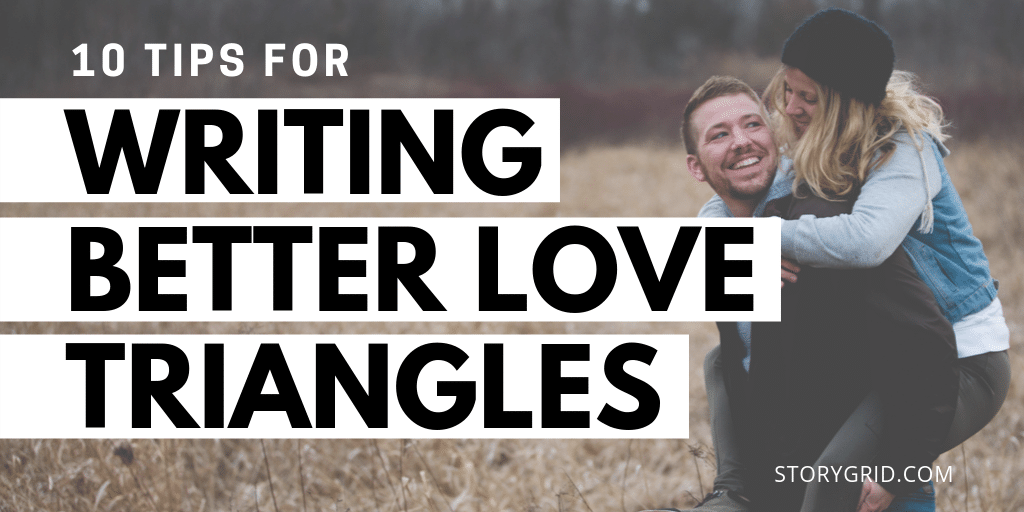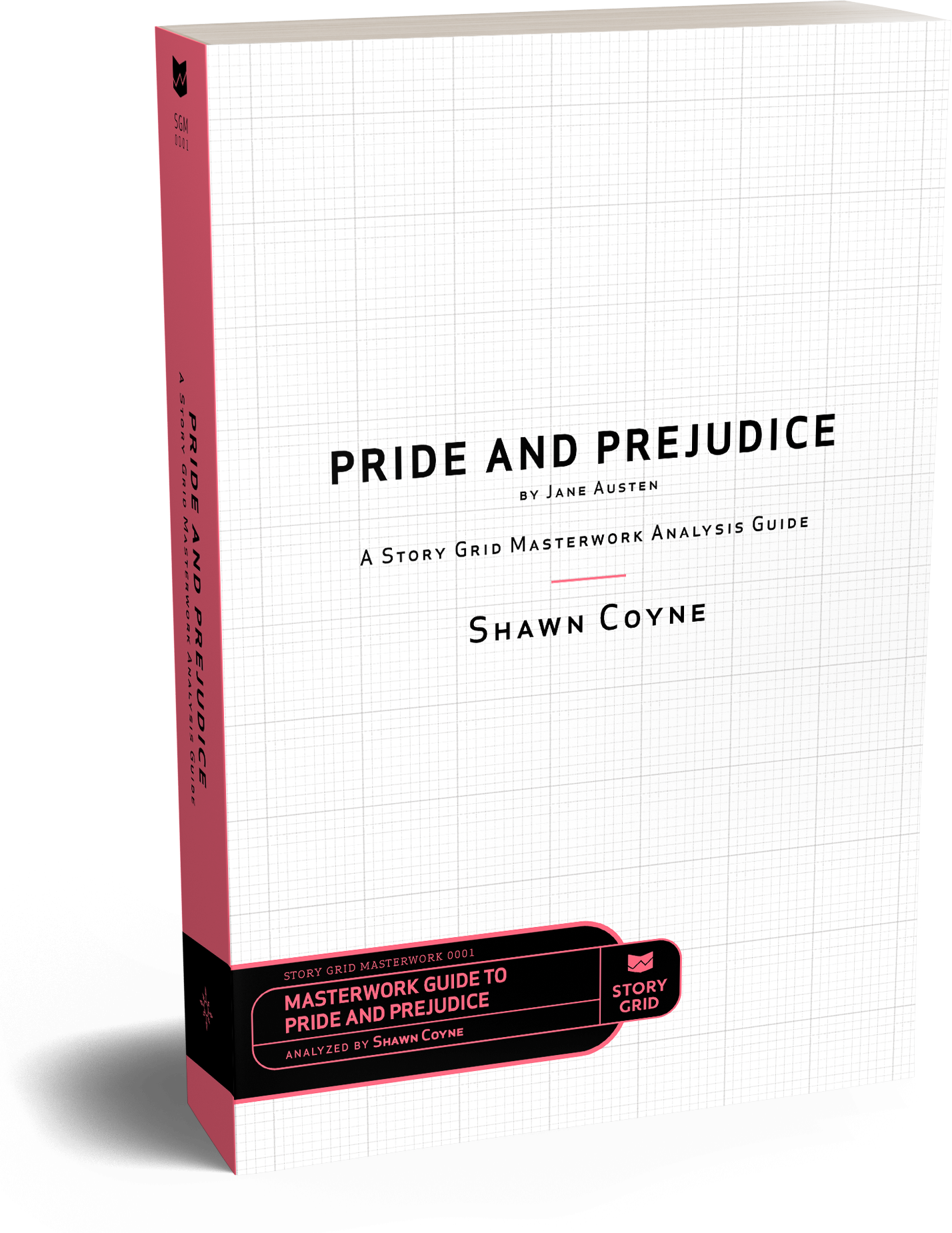
Fans of the romance genre appreciate a well-written love triangle. And it’s no secret that certain love triangles have shaped some of the most enjoyable stories in all of literature.
But how do you write a love triangle that will satisfy readers? How do you avoid your love triangle being labeled as “predictable” or even worse, “cliche?”
In today’s post, I’m sharing my top 10 tips to help you write better, more realistic, swoon-worthy love triangles that readers will adore.
But first, let’s make sure that we’re all on the same page about what makes a love triangle.

Access our In-depth Guide to the Love Genre
This 535-page books walks you scene-by-scene through Pride and Prejudice by Jane Austen, showing you exactly how to write a masterwork love story.
What is a love triangle?
A love triangle takes place between three (or more) characters. We’ll call them character A (the protagonist), character B (one suitor), and character C (the other suitor).
Characters B and C both love character A and compete for character A’s attention and affection. Character A loves both suitors (B and C), but can only choose one to b with.
Here are some examples of note-worthy love triangles:
- Elizabeth Bennet has to choose between Mr. Darcy and Mr. Wickham (Pride and Prejudice)
- Bella Swan has to choose between Edward Cullen and Jacob Black (Twilight)
- Katniss Everdeen has to choose between Peeta and Gale (The Hunger Games)
- Rory Gilmore has to choose between Jess and Dean (Gilmore Girls)
- Bridget Jones has to choose between Mark Darcy and Daniel Cleaver (Bridget Jones’ Diary)
Usually, there’s no relationship between the two suitors (character B and C), but sometimes they are friends, coworkers, or relatives.
Now that we’re on the same page about what a love triangle is, let’s talk about how to write one in your story. Here are my top 10 tips for writing better, more compelling love triangles that readers will adore and talk about for years to come.
10 Tips for Writing Better Love Triangles:
1. Fully develop each character involved in the triangle.
Your love triangle will be much more engaging to the reader when they know and care about each of the characters involved. In order for that to happen, you need to create three (or more) well-rounded characters. Each character needs to have their own goals, motivations, hopes, fears, values, comfort zones, and unique worldviews. All of these things are what help you create a push-pull dynamic that results in a compelling, and believable, love triangle.
When you don’t do this work for each of the characters involved in the love triangle, one of two things will happen. The reader will either end up rooting for only one of the suitors to win your protagonist’s heart, or they won’t really care about the outcome either way. Not ideal, right?
2. Make both suitors a viable choice for the protagonist.
Your protagonist should have legitimate reasons for loving both suitors and for not being able to choose one over the other right away. If one suitor is the “perfect person” for your protagonist and the other is the “wrong choice”, it’s not a hard decision. There will never be any doubt or suspense in the reader’s mind over who your protagonist will choose. In other words, your love triangle will be predictable. Your reader will probably feel less invested in the character who is painted as the “wrong choice,” and more invested in the “perfect person.”
So, do the work to develop both of the suitors as if they are each a viable romantic interest for your protagonist and not part of a larger love triangle. What kind of people would the suitors be? How would they complement and clash with your protagonist? What could your protagonist’s future look like with either person?
3. Don’t drag out the decision or go back and forth too much.
There’s no quicker way to bore the reader than to have your protagonist waffle back and forth between two love interests for too long. Yes, your character should have a hard time choosing between both suitors, but drag this indecision on too long, and you’ll likely annoy the reader.
Imagine if Elizabeth Bennet kept going back and forth between Mr. Wickham and Mr. Darcy over and over and over again. Would you be AS interested in the outcome? Probably not.
Plus, this unending indecision could lead the reader to feel like your story is going nowhere. Readers need that sense of forward momentum to keep them engaged in your story and turning the page to see what will happen next. If you keep repeating the same conflict, the story will become boring and predictable.
4. Have your protagonist actively choose someone to be with.
At some point, your protagonist will have to choose who they want to be with. If you make this decision too easy—for example, if one suitor dies or turns evil, leaving only one obvious choice—your reader will be disappointed.
People read stories to see how a particular character deals with things. When you don’t let your character make an active choice, you’re not delivering the experience readers are hoping for. There’s no quicker way to squash the reader’s interest than by having some kind of Deus Ex Machina swoop in and make the decision easy for your protagonist.
5. Show your protagonist’s character through their choice.
In a well-written romance, the climax of the story is more than just a decision that determines whether or not two characters get together. It’s also an opportunity for your character to resolve his or her internal dilemma and decide what kind of person he or she wants to be.
For example, in The Hunger Games, Katniss has to choose between Gale, representing who she was, and Peeta, representing who she’s become. In Twilight, Bella has to choose between a relationship with Jacob and a relationship with Edward. Jacob represents a normal, human life, while Edward represents a more difficult, immortal one. In both cases, Bella and Katniss have to choose what kind of person she wants to be. And choosing the kind of person your protagonist wants to be is far more interesting than simply choosing which guy is better looking, right?
6. You don’t have to start both relationships at the same time.
Not all stories will need to have a protagonist who is involved with both love interests at the same time. This is completely dependent on the story you want to tell and how you want to structure it. Although it may seem more dramatic to have both relationships happening at the same time, there are other ways to build tension in your story.
For example, your protagonist might only have feelings for one suitor at a time, like in Pride and Prejudice. Or, both suitors might have feelings for your protagonist at the same time, like in Bridget Jones’ Diary. You can even play around with the idea of familiarity vs. instant chemistry like in Gilmore Girls. These options each provide fertile ground for some good conflict to arise.
7. Establish what’s at stake with the decision.
To keep your love triangle from becoming stale, make sure there’s something at stake for your protagonist. Ask questions like–what is there to gain or lose when this love triangle blooms? What will happen if your protagonist chooses one suitor over the other? Will there be any regrets that he or she has to deal with following the decision? How will this decision impact your overall story?
Believe it or not, all of these questions do matter when it comes to creating a love triangle! For example, in Twilight, if Bella wants to be with Edward for the rest of his immortal life, she needs to become a vampire, too. That decision comes with a lot of consequences. She’ll have to go through a painful transformation, distance herself from her loved ones, and watch her friends and family grow old and die. Talk about major stakes!
8. Explore the different types of conflict within the triangle.
In your love triangle (and in your global story), you should be able to use all three types of conflict to keep your readers guessing right up until the end. Your protagonist will experience internal conflict as they choose between suitors. They’ll also experience external conflict as the love triangle impacts other people in their lives.
So, while you’re developing your love triangle, ask questions like–how does this affect my protagonist? How does this affect each of his or her suitors? How does this affect my protagonist’s friends and family? And how does this affect my protagonist’s world? If the effects of your love triangle can be felt throughout your story, then that adds unending value to its existence in your story.
9. Know where your love triangle fits in the story.
Before you start writing, it’s important to figure out whether you’re writing a romance novel or a story with a romantic subplot. This will determine the “weight” that the romantic relationship will carry in your story.
For example, in a romance novel, the relationship will be the main focus of the story. But that doesn’t mean that you get to ignore everything else that’s happening. In Twilight, Bella’s relationship with Edward takes center stage, but there’s still a lot going on around them. Bella is becoming better friends with Jacob, trying to fit in at her new school, dealing with life at her dad’s, and missing her mom, etc. There’s also the whole situation with James and Victoria who want to kill her (no big deal, right?).
Compare that to The Hunger Games where Katniss’ romantic relationships are subplots. The main story in The Hunger Games does not revolve around the conflict of Katniss trying to decide whether she loves Peeta or Gale best. Instead, the driving force of the story is Katniss’ fight for survival.
As you can see, both of these stories have much more going on than just the romantic relationships between characters. Each relationship carries a different “weight” in the overall story. As a result, each love triangle will carry a different weight, too.
10. Have a reason for including a love triangle in your story.
To write a love triangle that your reader will appreciate, it needs to exist for a reason beyond merely adding in drama. While it doesn’t have to be the sole focus of your story (as we determined in tip #9), it should have a solid purpose for existing. The less petty the purpose behind your love triangle, the more your readers will be invested in what happens.
So, ask yourself—why do you feel it must be in your story? What’s the reason for its existence? Why does it matter to your characters? Does the existence or the outcome of your love triangle support your theme? Why should your reader care about the outcome of your love triangle?
Final Thoughts
Love triangles are wonderful plot devices that can have beautiful, moving results. If you keep these 10 tips in mind, you’ll be more than prepared to create a compelling, swoon-worthy love triangle that readers adore! Happy writing!
For more tips on writing fiction, check out the archive of articles on Savannah’s website. You can also subscribe to her free newsletter to get writing and editing tips delivered straight to your inbox each week. If you’d like to work with Savannah on your story, you can learn more or get started by booking a FREE 30-minute strategy call here.
How do you feel about love triangles in fiction? Do you have a favorite fictional love triangle? Do you have any additional tips or tricks for writing a great love triangle? Let us know in the comments below!